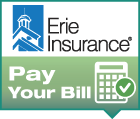You’ve might have heard of no-fault insurance. But do you know what it really is?
If not, the following Q&A will help clarify things for you. (In addition to the general information in this Q&A, we recommend you get specific advice from your local Erie Insurance Agent.)
What is no-fault insurance?
No-fault insurance applies to the personal injury protection PIP (also known as Medical Payments or First Party Benefits Coverage) part of your auto insurance policy. PIP covers medical expenses if you are in an auto accident. In some states, you can also be reimbursed for lost wages (and other expenses).
In a state with no-fault insurance laws, you file a claim for covered expenses with your auto insurance company if you are in a car accident. This applies whether you are at fault or not. Along with collecting from your own insurer regardless of fault, no-fault insurance restricts your right to file a lawsuit.
Which states have no-fault insurance?
There are currently 12 states with no-fault insurance: Florida, Hawaii, Kansas, Kentucky, Massachusetts, Michigan, Minnesota, New Jersey, New York, Pennsylvania, North Dakota and Utah.
In Kentucky, New Jersey and Pennsylvania, there is something a little different called choice no-fault. In a choice no-fault state, someone can choose to reject his or her state’s threshold in order to retain the right to sue under traditional liability law.
Why do some states have no-fault insurance?
The idea behind no-fault insurance is to avoid costly and time-consuming court cases (especially smaller court cases) and to ensure the prompt and timely payment of claims. If everyone can collect from their own insurer regardless of fault and there are certain thresholds you have to meet before suing, there are generally less court cases.
In which instances could I bring a lawsuit against an at-fault driver if I live in a no-fault state?
There are two ways states determine the thresholds that allow for lawsuits to proceed: verbal and monetary thresholds. Verbal thresholds describe a certain type of injury while monetary thresholds specify a dollar amount. Once you meet a threshold, you can sue for reimbursement of your actual damages (things like medical bills). Pain and suffering may still be excluded.
Five states have verbal thresholds (Florida, Michigan, New Jersey, New York and Pennsylvania) while seven states have monetary thresholds (Hawaii, Kansas, Kentucky, Massachusetts, Minnesota, North Dakota and Utah).
Since people can collect from their own insurer, does this mean that they don’t need to buy uninsured or underinsured motorist coverage?
It’s important to carefully consider uninsured and underinsured driver insurance since research shows that one in seven drivers lacks insurance (and many more have very minimal coverage).
Many drivers in no-fault states find it worthwhile to buy uninsured and underinsured motorist insurance. The extra protection you get from these policies may take care of any lost earning capacity or pain and suffering compensation not covered by your no-fault benefits.
It’s also wise not to rely on your health insurance as a full-proof guarantee if an underinsured or uninsured driver hits you. That’s because you might have a large deductible to pay. You could also exceed the maximum limit on your health insurance policy if your injury is serious.
Finally, keep in mind that it can be very stressful to sue an uninsured or underinsured driver for your medical expenses. By having your own coverage, there’s a much lower chance you’ll have to deal with this sort of stress.
No-fault insurance can be tricky. Fortunately, your Erie Insurance Agent can provide practical insurance guidance. We recommend checking in with him or her when you’re considering auto insurance.
Read the full story from Erie Insurance: "Q&A: What is No-Fault Insurance and Which States Have It?"
« For a Family Business, Every Day is Take Your Kids to Work Day Infographic: A Hands-Free Phone is Not Risk Free »



